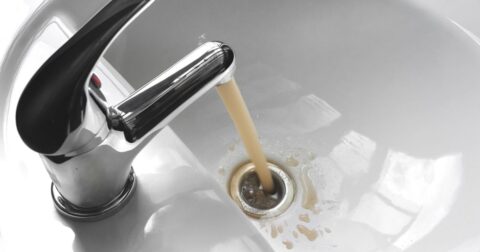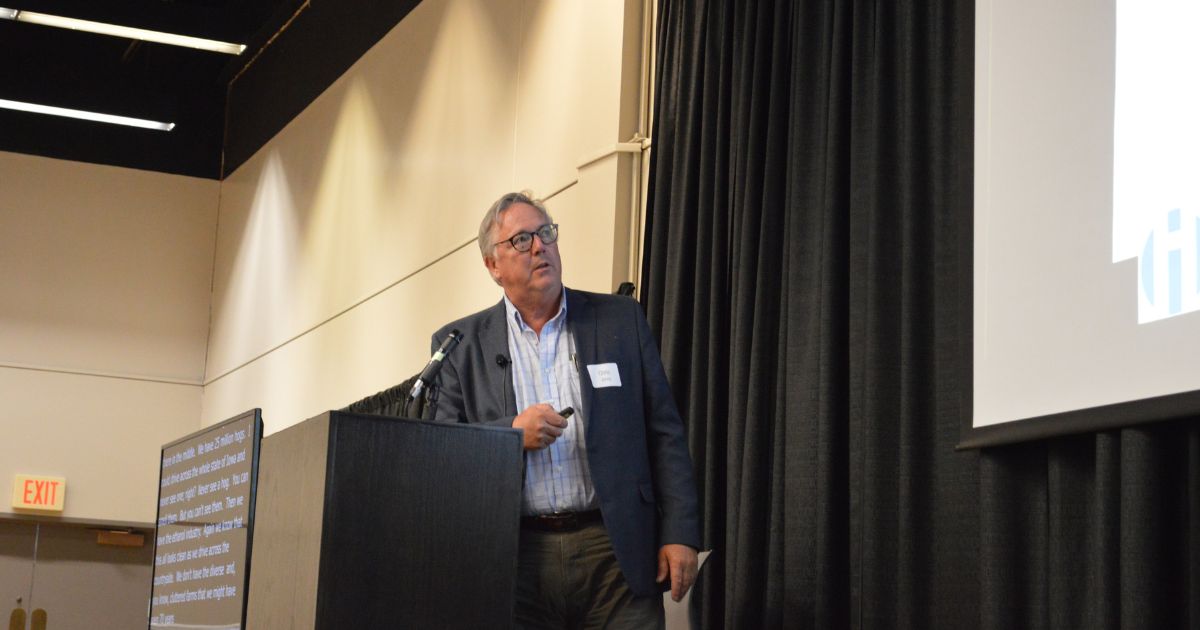News
Sentient Impact Report 2025
Policy•1 min read
Reported
The Ninth Circuit backed EPA’s response to polluted water: 'study further' and form a subcommittee.


Words by Nina B. Elkadi
When Nancy Utesch first moved to Kewaunee County, Wisconsin, a family in her community was poisoned after drinking water contaminated with E. coli, which has been tied to manure spread on nearby farms. The entire family went to the hospital, Utesch tells Sentient, and the eight-month old daughter spent time in intensive care.
“We were really stunned by the outpouring of support for the farmer and not the family,” she says. “Upon arriving here, we began to learn the inner workings of this very dysfunctional dynamic that [concentrated animal feeding operations] bring to a community, which really pits neighbors against neighbors.”
It was quite the first impression of her county, where she and her husband Lynn have now lived for the last 20 years. Utesch’s advocacy group, Kewaunee CARES, is one of 13 groups who sued the U.S. Environmental Protection Agency over their lack of enforcement of CAFOs under the Clean Water Act. On Oct. 2 the court denied the petition in full.
Utesch estimates that there were approximately two concentrated feeding operations, or CAFOs, in Kewaunee County when she moved there. Now, according to new data compiled by Food & Water Watch, Kewaunee County has 36 factory farms which produced over 2 billion pounds of waste in 2022. The manure from CAFOs is often kept in open-air lagoons, where it is stored until it is sprayed to fertilize agricultural fields. Any excess manure not soaked up by crops or grasses ends up in aquifers and waterways, contaminating wells with nitrate and causing health issues ranging from acute poisoning to cancer. In some states, like Iowa, animals in CAFOs produce 25 times as much waste as its human population.
The 13 groups were represented by Food & Water Watch staff attorney Emily Miller, who in September argued in front of the Ninth Circuit Court of Appeals in San Francisco. EPA itself has admitted that fewer than 30 percent of CAFOs have Clean Water Act permits. In the petition denial EPA sent Food & Water Watch six years after the initial petition was filed in 2017, they wrote, “EPA shares your concern that CAFOs can be a significant source of pollutants into waters of the United States. The Agency recognizes that there may be opportunities to do more to address these pollutants.” EPA’s solution was to form a committee to determine next steps — a decision which the petitioners felt was too little, too late.
“EPA needs to really step up in their actions so that they can actually protect people and not just be saying, ‘Oh, we’re going to have more stakeholder meetings,’” Utesch says. “During all these years, all that’s happened is further expansion.”
In their denial, the judges wrote that though the agency acknowledged “the serious problem of CAFO-based waste discharges into U.S. waterways,” its promise to “further study” its own manure pollution guidelines and “commission a stakeholders’ subcommittee” was not an unreasonable response.
“The EPA has never demonstrated an urgency to the outright widespread devastation and impoverishment CAFOs leave in their wake,” Utesch wrote in a text. “The well of ‘hope’ people echo we must keep is contaminated, and will continue to grow in its contamination, as long as EPA is beholden to corporate interests above the people their agency was designed to protect.”

The Clean Water Act was officially born in 1972, or in an era when cattle and pig CAFOs were coming to be the norm. Within the Clean Water Act, CAFOs are classified as “point sources” of pollution, requiring them to have National Pollution Discharge Elimination System (NPDES) permits. But according to petitioners in Food & Water Watch et al. v. EPA, “Half a century later, the United States Environmental Protection Agency’s regulation of CAFOs has become one of the Clean Water Act’s greatest unmet promises.”
Food & Water Watch first submitted a petition on behalf of 32 environmental organizations in 2017, “urging the agency to fix its failed factory farm program under the Clean Water Act,” Miller tells Sentient.
The case outlines two main issues with the current EPA regulatory structure for CAFOs — one being that most factory farms discharge pollution but lack the required federal permits to control these discharges, and the second being that the permits themselves are insufficient to protect waterways and communities from pollution.
“The reason why these things are happening is because of agricultural exceptionalism,” says Silvia Secchi, a professor of geographical and sustainability sciences at the University of Iowa. “EPA is treating agriculture as this kind of special sector that gets a pass, and then gets a second pass and a third pass.”
The biggest “pass” in question in this lawsuit is the agricultural stormwater discharge exemption. Under the current EPA rule, Miller says, as long as factory farms are applying waste in accordance with a nutrient management plan, any discharges that are precipitation-related from its land application areas are exempt from regulation.
“What has happened is that this has essentially allowed thousands of operations to completely evade permitting requirements altogether for their nonexempt discharges, because it provides them an easy out to explain away any evidence of discharges coming from their facilities,” she says. “It requires almost no oversight from EPA or any other state agency to confirm that the operation is actually meeting the exemption.”
This limited oversight is causing destruction to communities who live closest to the polluters. There are downstream effects, too, as pollution from agricultural states is the largest contributor to the “dead zone” in the Gulf of Mexico.
The issue of CAFO pollution is a problem of scale, Chris Jones, water quality expert and president of Driftless Water Defenders recently said at an event on animal agriculture held in Des Moines. The solution does not exist in technological fixes or manure-treatment initiatives.
Instead, Jones says, “We need laws. We need laws that are going to help us get our arms around this and give us the environmental condition in this state that we deserve as citizens.”
Secchi agrees.
“We need to see litigation as the way civil society responds to a captured agency,” she tells Sentient. “Ideally we would have a more responsive Congress that does things to address new challenges…But because Congress cannot tie their shoelaces, what we have are these laws that have some good bones.”
In 2023, the EPA acknowledged that there was a significant problem with CAFO permitting and that their current regulations are failing to address it. But instead of addressing it head-on, Miller says, they decided to study it further.
“EPA is on record in a 2022 report stating that not only have its regulations failed to address the problem, but they are actually impeding effective enforcement of the Clean Water Act,” she says. “In other words, the problem is persisting, not just in spite of EPA regulations, but because of them. What else does the EPA need to know?”
In court in September, Judge Salvador Mendoza asked EPA counsel in the Ninth Circuit of Appeals, “Why isn’t now the time?” He added, “You don’t need additional studies to understand the fact that you need to enforce the permitting process.”
On Oct. 2, 2024, the judges released their final decision: “Because we find that EPA did not act arbitrarily, capriciously, or contrary to law, we deny the petition.”
The decision comes as CAFO waste reaches untenable levels nationwide. According to Food & Water Watch, approximately 1.7 billion animals live in confinement on factory farms, producing 941 billion pounds of manure each year. And when it comes to pollution, Des Moines Water Works, which has the world’s largest nitrate removal facility, must run their sometimes $10,000 per-day facility to keep drinking water safe for its residents when nitrate levels are high.
“We need judges who understand the reality of current agricultural production systems, the immediacy of the problems we face and the extensive evidence we already have,” Secchi wrote in a text upon hearing the decision. “This panel [of judges] gave EPA leeway to keep kicking the can down the road. That’s not a tenable situation.”
Upon hearing the decision, Miller wrote in an email to Sentient: “We are of course disappointed by the decision. It’s shocking that the court gave such short shrift to a critical issue. We’ll keep working to hold EPA accountable for its decades of failure.”
For Utesch, the entire process of petitioning and suing the EPA has instilled in her a belief that the agency is not serious about enforcing CAFO pollution, especially as it relates to human health.
“The CAFO issue is directly tied to human rights: the right one has to protecting personal health, home, air and water quality and quality of life, all which are severely compromised by industrial agribusiness,” Utesch wrote. “EPA must remember and fulfill its mission, which is to protect.”